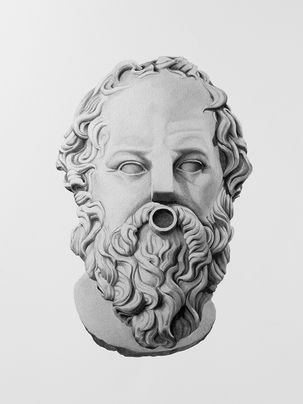
Aristoï
2020 - in progress
After going through the material, questioning the form, establishing a plastic anthropology – of plastic; after creating a Cesare Lombroso-style catalog (the Enosim series) of characteristics that show all our criminal guilt; after this pious catalog which destroys the very concept of piety; after this vigil of ghosts, which we are, which we have produced and of which we are the product. Then came a transfer. It turns out that art has visionary abilities, it sees with the eyes of the whole world, a powerful cyclopean gaze. An artist glimpses a new classicism. A new Kalòs kai Agathòs, a new theater, new powers, a new solitude. Where we no longer talk about beauty.
We don't talk anymore.
Apparently that's the end of the story.
What did Thierry Konarzewski see, what is he obliged to reveal to us, in a grueling exercise of manual transcription, an exercise in engraving?
This plastic pandemic has affected classical statuary. New heroes have been generated, in a constant mutation, which perhaps has no end. The languages in which the artist felt trapped have disappeared: photography is no longer a living thing, but a final tool. It is the drawing that becomes a living thing. Drawing is the new language, the oldest, troglodyte and apotropaic.
With drawing, Konarzewski realizes his concept of mutation, through very slow interventions - in pencil - of cosmetic surgery on ancient heroes, whose names he also slightly changes, inverting the syllables, dissolving the diphthongs, generating hiatuses. Then he photographs his portraits, mimicry of mimicry.
If before his photography was vision, now it is taxidermy. It is no longer the search for souls in waste, it no longer makes the photographer a medium. Here, it is a diminutive of photography, which in fact becomes a digital notebook. The artist's intention is to remake these images and make them into photographic objects.
Like the wandering souls of Enosim, we remain “The Best”. In a hundred, a thousand years. Without sight, identifiable by the nasal handle and the screw mouth orifice. Paralyzed mythological names. If it had been better not to be born, Oedipus said to Colonus, we would return to where we started. Where we came from.
As in the previous series, there are no references here to selective collection, to recycling, to a vague and distorted aesthetic of waste. We are in a scandalous afterlife, in a desolate landscape. We are in the last gallery still intact, on the ruins of an archaeological museum which does not yet exist, after having anticipated the future to soothe our “anxiety of the infinite”.
Raffaella Venturi - Critic art and curator
—
April 2020, Paris
The ARISTOÏ series is my question about Mutation.
How to represent and bear witness to the physiological, physical and mental mutation of a society, of its people in contact with a foreign body like plastic.
ARISTOÏ tells of a future past, a time when the social rank of the elites and the people was identified not by dress codes but by physique. For the elites, the Mutation had chosen their noses and their mouths. I revisited portraits from the Greco-Roman era, particularly honorary statuary, knowing that there were other motivations in ancient sculpture than aesthetic idealization, such as religious, votive, commemorative and political functions. Over the centuries, from temples to bourgeois interiors via artists' studios, art schools and public gardens, this artistic expression has invaded our collective unconscious. She remains the reference of classic beauty and the votive witness of our society.
The project is to create photographic objects. I drew the characters then photographed them in the studio. I then worked in post production to obtain a cold 3D type appearance leaving the defects and marks of study work.
The ARISTOÏ series suggests the dreamlike mutation of a plasticized society as both a physical and metaphysical matrix of new men within an unchanged social organization. It is both a condemnation and a celebration.
—














